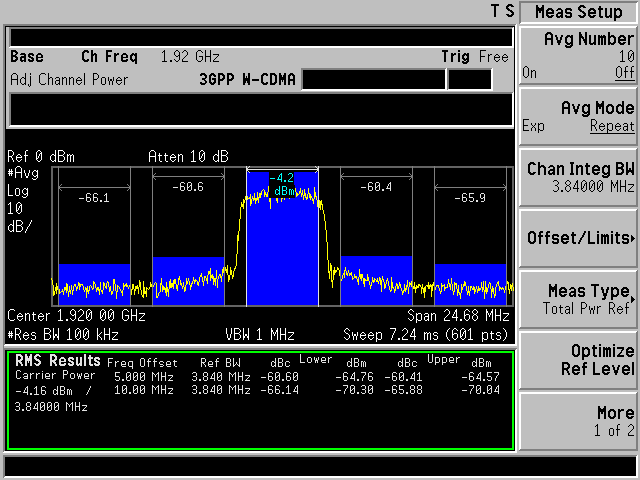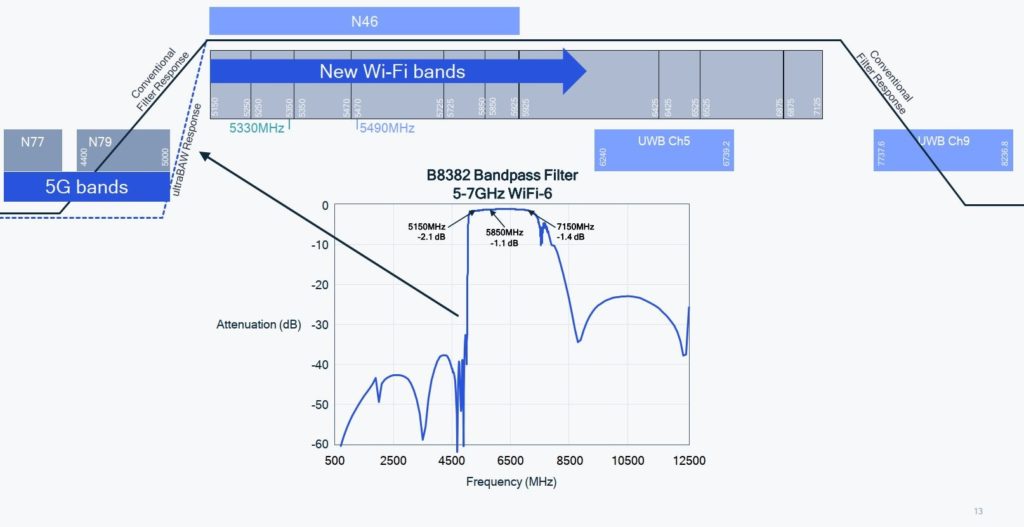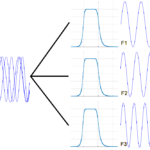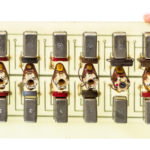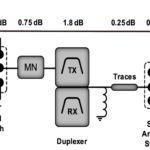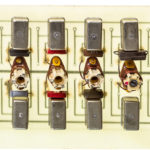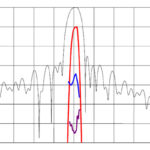Qualcomm’s ultraBAW filters cover 2.7 GHz to 7.2 GHz, keeping cellular and Wi-Fi in place. Qualcomm explains how the filters work.
Each time a government auctions off a slice of spectrum for cellular use, the airwaves get more crowded as users begin occupying the new frequencies. In the days when spectrum wasn’t so scarce, cellular frequency bands could have wide guard bands between each other or between themselves and other bands. Plus, other services such as Wi-Fi have expanded. Wi-Fi 6e, for example, occupies the 6 GHz band. At 4.4 GHz to 5.0 GHz, the cellular n79 band sits just below the 5 GHz Wi-Fi band. RF bandpass filters constrain the energy to the appropriate frequencies.
Each time a new cellular frequency comes into use, or an existing cellular band grows, base stations and use equipment need new filters to minimize Adjacent Channel Power Ratio (ACPR) and thus interference. Figure 1 shows an ACPR measurement.
Figure 1. RF filters keep a transmitters power constrained to specified frequency bands. Image: Keysight Technologies
Qualcomm has introduced bulk acoustic wave (BAW) filters to cover frequency bands from 2.7. GHz to 7.2 GHz. Dubbed “ultraBAW,” the filters complement surface acoustic wave (SAW) filters that handle lower frequencies. According to the announcement, ultraBAW filters will be available in the second half of 2022.
To get an understanding of the physics and applications for BAW filters, 5G Technology World spoke with Qualcomm’s Pierre-Alexander Girard, Max Rodrigues, and Phillippe Cortese.
“Wi-Fi 6 and 6e must play well together with 5G,” said Rodrigues. “The 5 GHz and 6 GHz frequencies go beyond the capabilities of SAW filters. The crowded frequency bands need filters with better precision than ever before.” Figure 2 shows where a filter fits between the 5G band n79 and the 5 GHz Wi-Fi band (n46). In this case, the filter for the n46 band needs a sharp cutoff at the low end because of the 150 MHz guard band between it and the n79 band. At the high end, the filter’s roll off can come down more slowly because there’s less activity at those higher frequencies. Should the 12 GHz band come into use, new devices may need additional filters.
Figure 2. a bandpass filter covering the 5 GHz and 6 GHz Wi-Fi bands needs a sharp low-frequency cutoff to prevent interference with the n79 cellular band. Image: Qualcomm
Girard explained the underlying physics of the ultraBAW filters. Using a piezoelectric material BAW filter converts electrical energy to mechanical energy and back, and does so in a 1 mm² package. An aluminum nitride (AlNi) piezoelectric material (Figure 3) compresses based on an applied voltage.
Figure 3. A piezoelectric later between to metal electrodes set a BAW filter’s resonant frequency. Image: Qualcomm
While a SAW filter uses fingers and a surface, BAW filters resonate in the bulk AlNi material, which resonates vertically. Two metal plates surround the material. The resonant frequency is a function of the piezoelectric material’s size. The mechanical construction creates a resonator, which resonates at a specified center frequency and bandwidth, creating a bandpass filter. The coupling factor relates to the filter’s bandwidth.
“Changing the sandwich changes the frequency,” said Girard. We set the frequency through the width and through loading of the piezoelectric material. We also use lithography and tuning to achieve the final frequency.”
Girard said that, although the ultraBAW filters operate down to 2.7 GHz, the physics lets BAW filters operate down to 1.7 GHz, creating a 1 GHz overlap with SAW filters. “Below 1.7 GHz,” said Girard, BSW filters get too large to be practical.”
While mobile devices need a filter for each band, a single band often contains several channels. A filter will cover the entire band, but the modem decides which channel a given connection will use. Channel width will depend on usage.
Because today’s mobile devices must operate across many frequency bands, they need a filter for each band. What happens when a government holds a spectrum auction? Does that mean you need a new phone to use those frequencies? The answer is no, according to Girard. Filter manufacturers know well in advance which frequencies will be on the auction block, allowing time to design the necessary filters and for device manufacturers to include them in new devices. “We make filters for upcoming bands available to engineers before knowing which carrier will acquire them,” said Cortese. In addition, Cortese noted that customers will request filters for specific bands or combinations of bands. “Sometimes we combine bands in a given filter.”
Related articles
- Bulk acoustic wave filters make life easier for Wi-Fi front-end designers
- Filters, Part 2: SAW and BAW devices for RF
- Wi-Fi 6E cometh: FCC opens 1200 MHz of spectrum to unlicensed communications
- https://www.5gtechnologyworld.com/wi-fi-6e-is-coming-chipsets-with-mimo-now-sampling/
- 5G RF filters need more innovation

